Typical values at TA = +25°C with nominal supplies. Default conditions: TX input data rate = 491.52MSPS, fDAC = 11796.48MSPS (24x interpolation), interleave mode, 1st Nyquist zone output, PLL clock mode with fREF = 491.52MHz, AOUT = –1 dBFS, DSA = 0dB, Sin(x)/x enabled, DSA calibrated
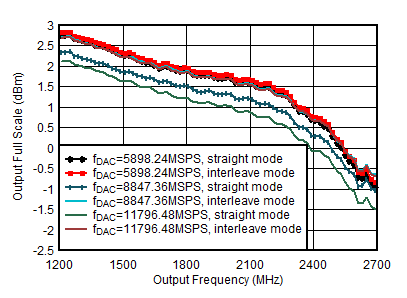
| including PCB and cable losses, Aout = -0.5dFBS, DSA = 0, 1.8GHz matching |
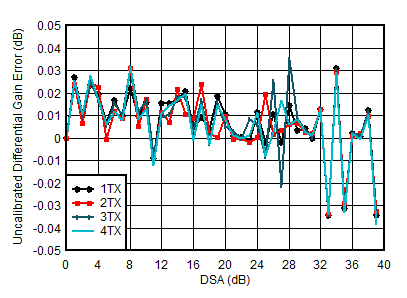
| fDAC = 5898.24MSPS, interleave mode, matching at 1.8GHz |
| Differential Gain Error = POUT(DSA Setting – 1) – POUT(DSA Setting) + 1 |
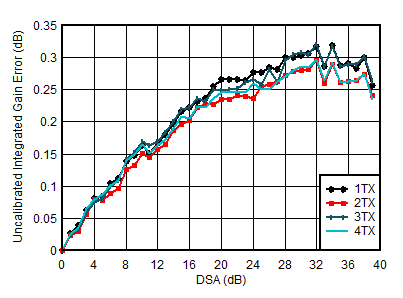
| fDAC = 5898.24MSPS, interleave mode, matching at 1.8GHz |
| Integrated Gain Error = POUT(DSA Setting) – POUT(DSA Setting = 0) + (DSA Setting) |
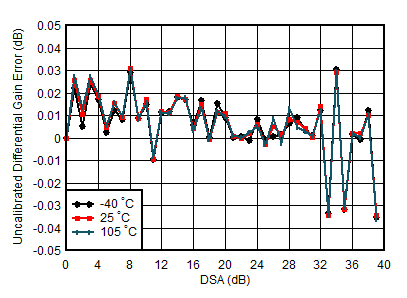
| fDAC = 5898.24MSPS, interleave mode, matching at 1.8GHz |
| Differential Gain Error = POUT(DSA Setting – 1) – POUT(DSA Setting) + 1 |
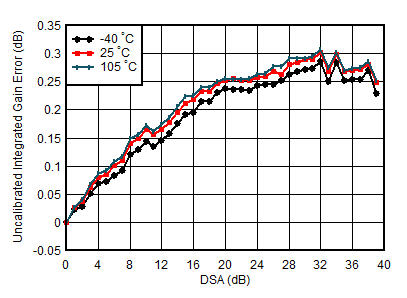
| fDAC = 5898.24MSPS, interleave mode, matching at 1.8GHz |
| Integrated Gain Error = POUT(DSA Setting) – POUT(DSA Setting = 0) + (DSA Setting) |
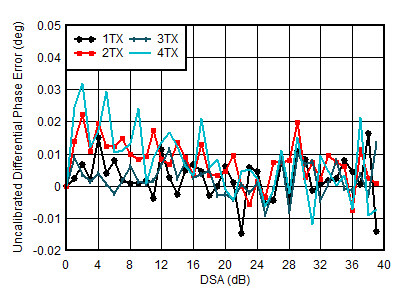
| fDAC = 5898.24MSPS, interleave mode, matching at 1.8GHz |
| Differential Phase Error = PhaseOUT(DSA Setting – 1) – PhaseOUT(DSA Setting) |
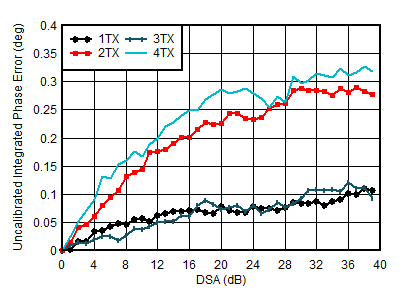
| fDAC = 5898.24MSPS, interleave mode, matching at 1.8GHz |
| Integrated Phase Error = Phase(DSA Setting) – Phase(DSA Setting = 0) |
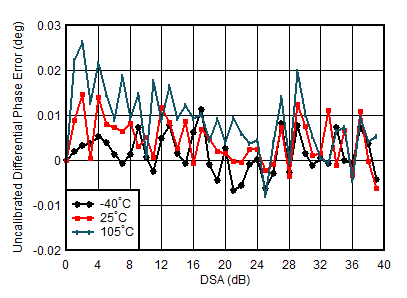
| fDAC = 5898.24MSPS, interleave mode, matching at 1.8GHz |
| Differential Phase Error = PhaseOUT(DSA Setting – 1) – PhaseOUT(DSA Setting) |
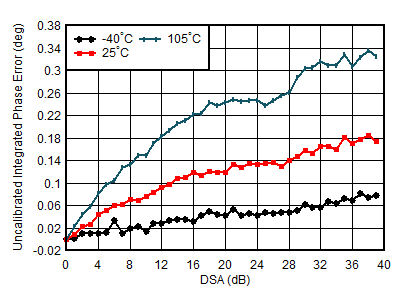
| fDAC = 5898.24MSPS, interleave mode, matching at 1.8GHz, channel with the median variation over DSA setting at 25°C |
| Integrated Phase Error = Phase(DSA Setting) – Phase(DSA Setting = 0) |
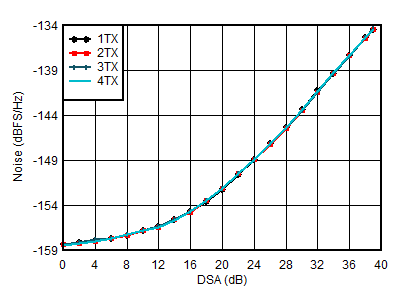
| fDAC = 5898.24MSPS, interleave mode, matching at 1.8GHz, POUT = –13dBFS |
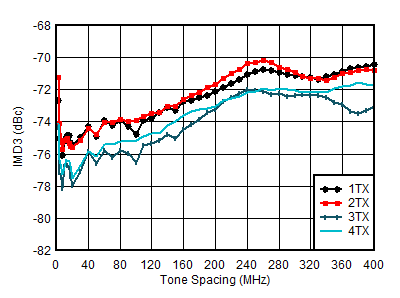
| fDAC = 11796.48MSPS, interleave mode, fCENTER = 1.8GHz, matching at 1.8GHz, –13dBFS each tone |
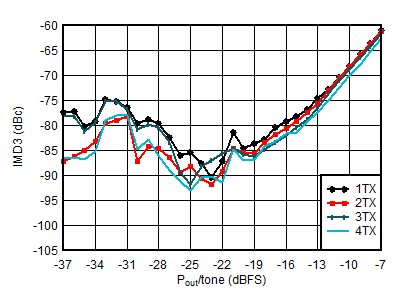
| fDAC = 11796.48MSPS, interleave mode, fCENTER = 1.8GHz, fSPACING = 20MHz, matching at 1.8GHz |
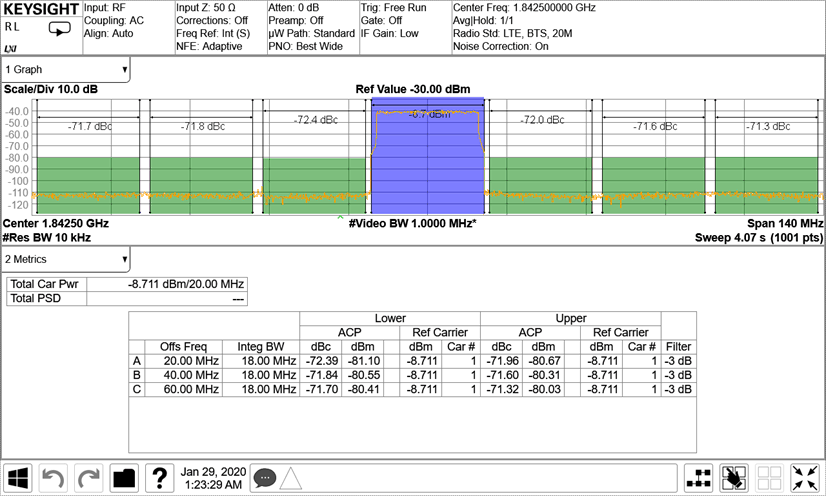
| TM1.1, POUT_RMS = –13dBFS |
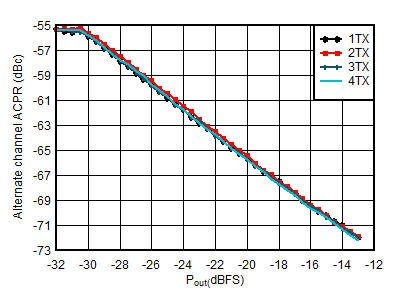
| Matching at 1.8GHz, single carrier 20MHz BW TM1.1 LTE |
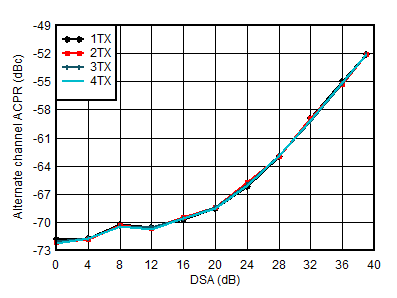
| Matching at 1.8GHz, single carrier 20MHz BW TM1.1 LTE |
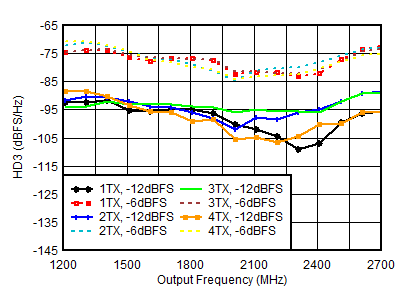
| Matching at 1.8GHz, fDAC = 11.79648GSPS, interleave mode, normalized to output power at harmonic frequency |
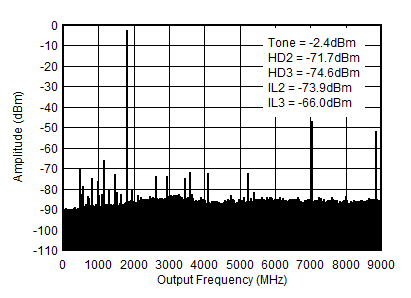
| fDAC = 8847.36MSPS, straight mode, 1.8GHz matching, includes PCB and cable losses. ILn = fS/n ± fOUT and is due to mixing with digital clocks. |
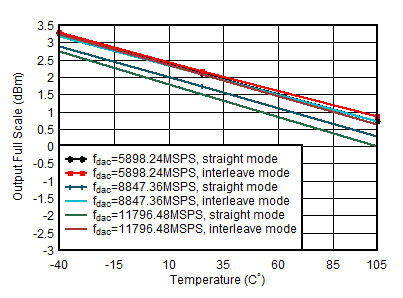
| Aout = -0.5dFBS, matching 1.8GHz |
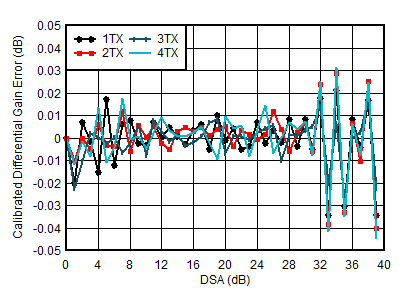
| fDAC = 5898.24MSPS, interleave mode, matching at 1.8GHz |
| Differential Gain Error = POUT(DSA Setting – 1) – POUT(DSA Setting) + 1 |
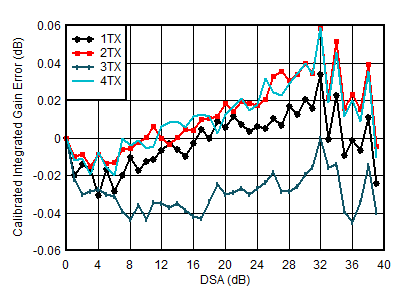
| fDAC = 5898.24MSPS, interleave mode, matching at 1.8GHz |
| Integrated Gain Error = POUT(DSA Setting) – POUT(DSA Setting = 0) + (DSA Setting) |
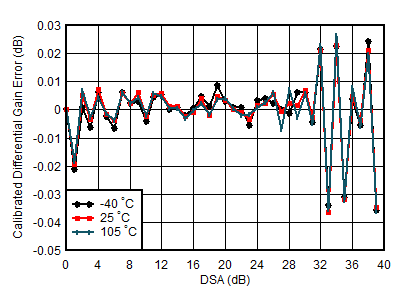
| fDAC = 5898.24MSPS, interleave mode, matching at 1.8GHz |
| Differential Gain Error = POUT(DSA Setting – 1) – POUT(DSA Setting) + 1 |
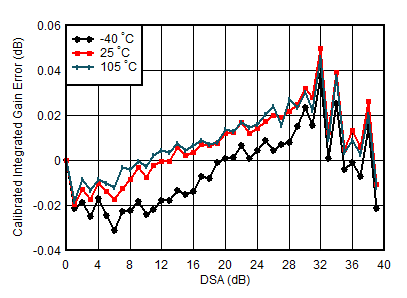
| fDAC = 5898.24MSPS, interleave mode, matching at 1.8GHz |
| Integrated Gain Error = POUT(DSA Setting) – POUT(DSA Setting = 0) + (DSA Setting) |
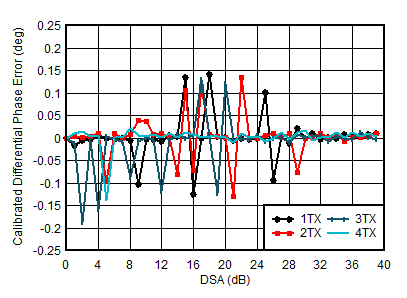
| fDAC = 8847.36MSPS, straight mode, matching at 2.6GHz |
| Differential Phase Error = PhaseOUT(DSA Setting – 1) – PhaseOUT(DSA Setting) |
| Phase DNL spike may occur at any DSA setting. |
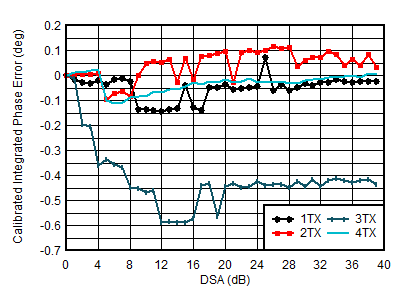
| fDAC = 5898.24MSPS, interleave mode, matching at 1.8GHz |
| Integrated Phase Error = Phase(DSA Setting) – Phase(DSA Setting = 0) |
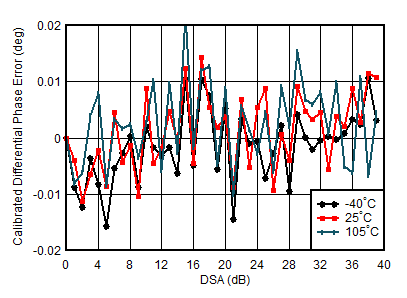
| fDAC = 5898.24MSPS, interleave mode, matching at 1.8GHz, channel with the median variation over DSA setting at 25°C |
| Differential Phase Error = PhaseOUT(DSA Setting – 1) – PhaseOUT(DSA Setting) |
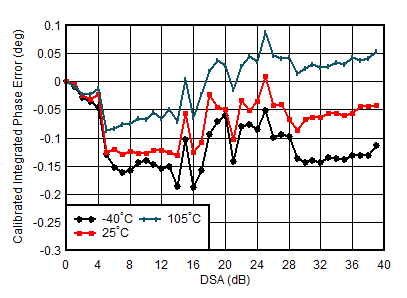
| fDAC = 5898.24MSPS, interleave mode, matching at 1.8GHz, channel with the median variation over DSA setting at 25°C |
| Integrated Phase Error = Phase(DSA Setting) – Phase(DSA Setting = 0) |
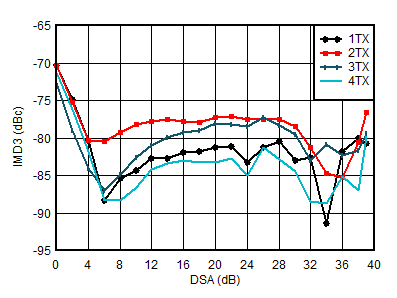
| fDAC = 11796.48 MSPS, interleave mode, fCENTER = 1.8GHz, matching at 1.8GHz, –13dBFS each tone |
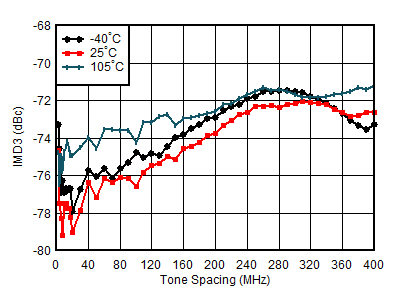
| fDAC = 11796.48MSPS, interleave mode, fCENTER = 1. GHz, matching at 1.8GHz, –13dBFS each tone, worst channel |
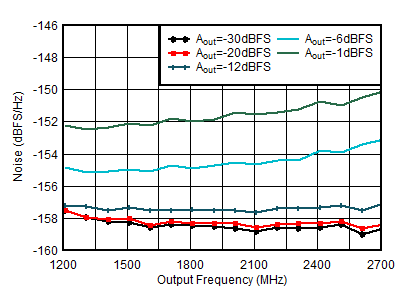
| Matching at 2.6GHz, Single tone, fDAC = 11.79648GSPS, interleave mode, 40MHz offset |
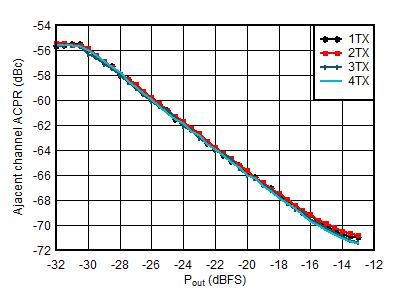
| Matching at 1.8GHz, single carrier 20MHz BW TM1.1 LTE |
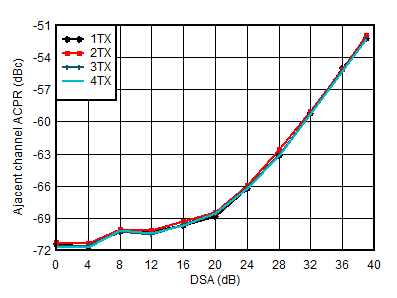
| Matching at 1.8GHz, single carrier 20MHz BW TM1.1 LTE |
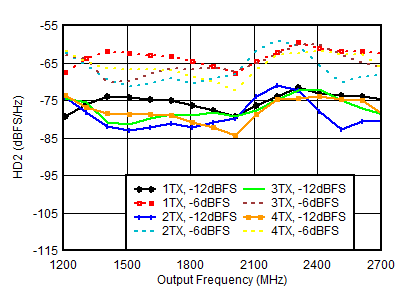
| Matching at 1.8GHz, fDAC = 11.79648GSPS, interleave mode, normalized to output power at harmonic frequency |
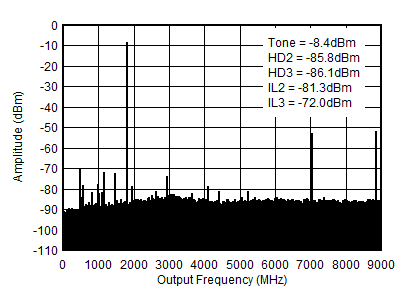
| fDAC = 8847.36MSPS, straight mode, 1.8GHz matching, includes PCB and cable losses. ILn = fS/n ± fOUT and is due to mixing with digital clocks. |
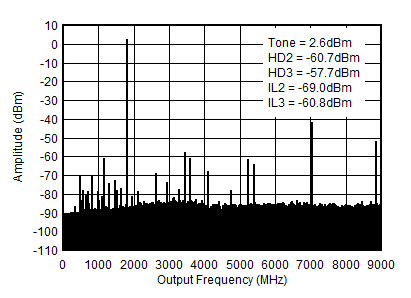
| fDAC = 8847.36MSPS, straight mode, 1.8GHz matching, includes PCB and cable losses. ILn = fS/n ± fOUT and is due to mixing with digital clocks. |

































